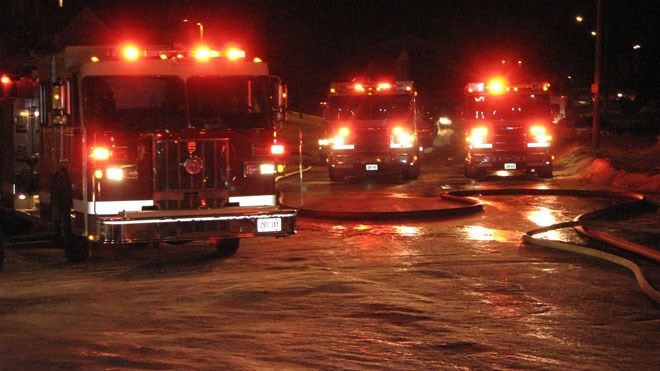When you invite people to a party, it’s your responsibility as the host to ensure your guests have everything they need — that’s Hosting 101.
On Monday, the city invited people to the first of eight public meetings on a sweeping plan to overhaul Greater Sudbury Fire Services. The second meeting was Wednesday.*
The service is still very much the kludge it was after amalgamation, a hodge-podge of inherited services, a mix of volunteer and career firefighters, with stations located in places more suited to serving pre-amalgamation communities.
Clearly, the fire service is due to be updated and, in the words of Trevor Bain, chief of fire and paramedic services, “optimized” to ensure better, more thorough coverage and quicker response times. This will be an expensive and complex process, but it’s necessary to ensure all of us, no matter what part of our city we live in, have the best fire protection possible.
Hence, these public meetings (the last being on March 16), which are to provide an opportunity for residents to learn why the GSFS needs to be overhauled and updated, how much it could cost to do that and how the department will change.
It’s also supposed to be an opportunity for the public to ask questions of the bureaucrats making the recommendations.
So far, so good.
But by all accounts — from the Sudbury.com reporters who covered it to the people inside the library in Lively to the many stuck outside because the venue was too small — the first public meeting did not go well.
This is an important issue — it’s our fire protection service, after all. Residents should understand why Bain feels the plan he’s pushing is the best way forward. In his defence, it’s not simple.
The chief actually sat down individually with reporters to go over the plan he’s presenting to help them better understand its intricacies and nuances, so that journalists would have a handle on it before they started reporting.
This week, Sudbury.com reporter Darren MacDonald (no stranger to marathon-length meetings on inconceivably dry topics) gave a thorough analysis of Monday’s meeting, and a breakdown of the plan itself.
But the problem with public meetings is, if you don’t do it right, you end up doing more harm than good.
So, for the upcoming meetings and for the benefit of residents and bureaucrats alike, here are a few tips on being a good host (or for holding better public meetings).
The more seats, the merrier. Don’t invite the public to a meeting in a space that can’t hold them. It not only shows poor planning, it also shows organizers didn’t care enough about the public to make the meeting accessible to most. People in Lively on Monday are understandably irritated from the get-go because the venue was so small. People won’t listen to a word you have to say if you make them angry before the meeting even starts.
Monday’s meeting was plagued with a microphone that kept cutting out and a digital presentation that wouldn’t load reliably. Test the microphone and sound system before the meeting, make sure it works. Also, bring a digital copy of the presentation on a laptop or portable thumb drive so you’re not at the mercy of sometimes spotty WIFI. If people can’t hear you or they have to wait while your presentation loads page elements from a bad connection, you might as well cancel the meeting — you’ve lost them.
If you invite people to ask questions, maybe facilitate by, let’s say, having microphones set up and s system of organization in place so people aren’t shouting over one another. This isn’t the White House press gallery. If you’re having a question and answer period, make sure it isn’t a chaotic mess. People hate that.
Don’t force busy people to sit through hour after hour of facts and figures, graphs and minutiae, then expect them to have good questions. What you’ll have is annoyance and anger. The city isn’t releasing the optimization plan to the public for awhile. What’s the logic there? Better to release it now, with a one-page detailed summary that includes the main goals of the plan, the rationale, and some data and dollar figures. That way people aren’t walking into the meeting cold – they can read the summary while they’re waiting for it to start, if need be — and will ask better questions.
I guarantee you, after being crammed into a too-small room and forced to listen to more than two hours of bureaucratic droning, all people heard was: a) The city wants to hire more expensive career firefighters; b) The city wants to axe inexpensive, experienced volunteers in favour of more, and more expensive, career firefighters, and; c) The city wants to spend $15 million more a year on fire protection.
Instead of answering questions, the city just made people angry.
There’s probably a rationale in Bain’s plan. Unfortunately, a poorly planned and orchestrated meeting made it so most people couldn’t see what rationale it might contain. It seems the city may have gotten the message, thankfully. The chief has said he plans to shorten the meetings, and an additional meeting has been added in Lively for March 16 to accommodate those who couldn't attend Monday.
And one additional item, don’t threaten to kick everyone out of a party you invited them to when they get mad you forgot the punch, the snacks and the music. It’s your party, that’s on you.
You want people to dance, don’t you?
*The city added four additional meetings shortly after the publication of this editorial.
